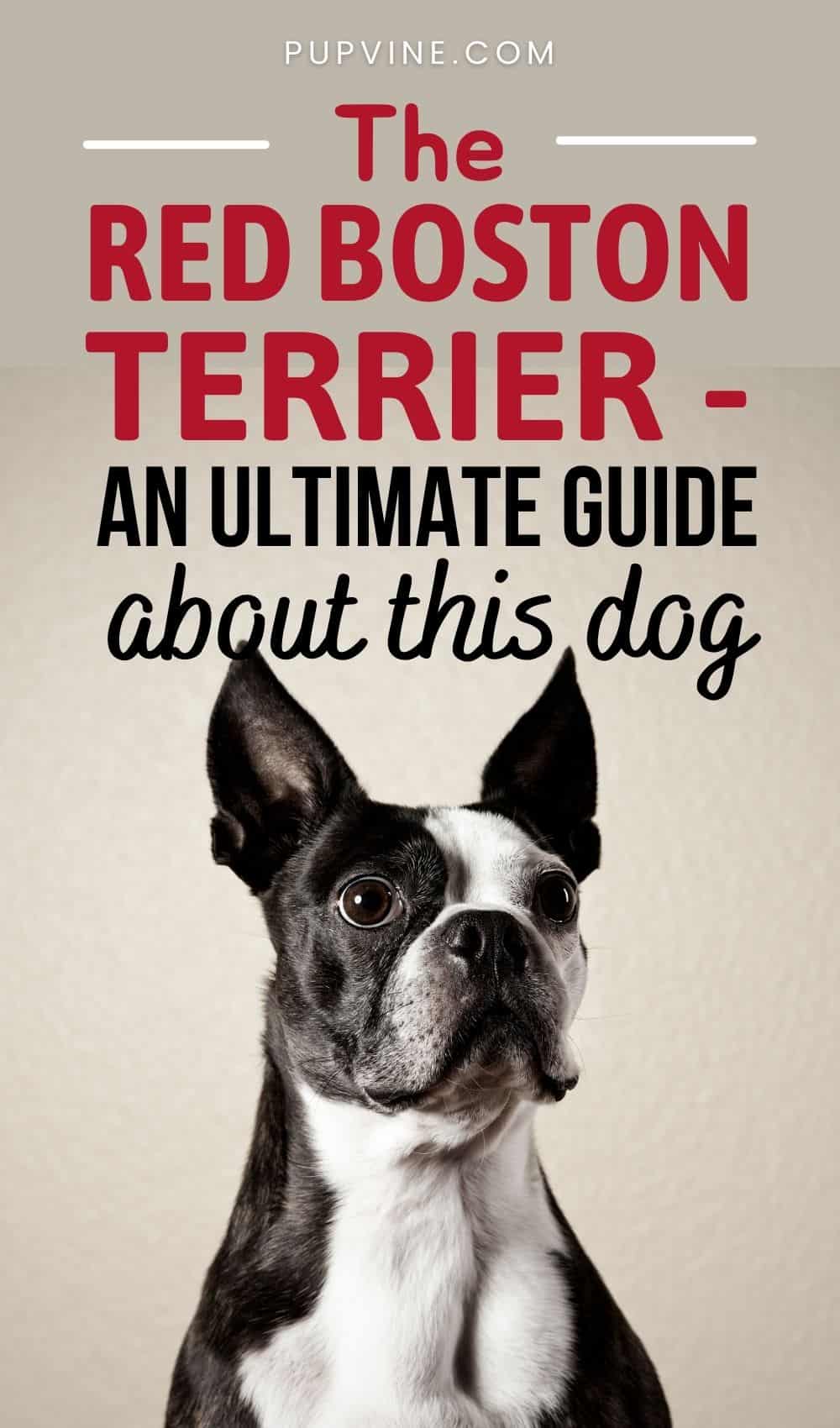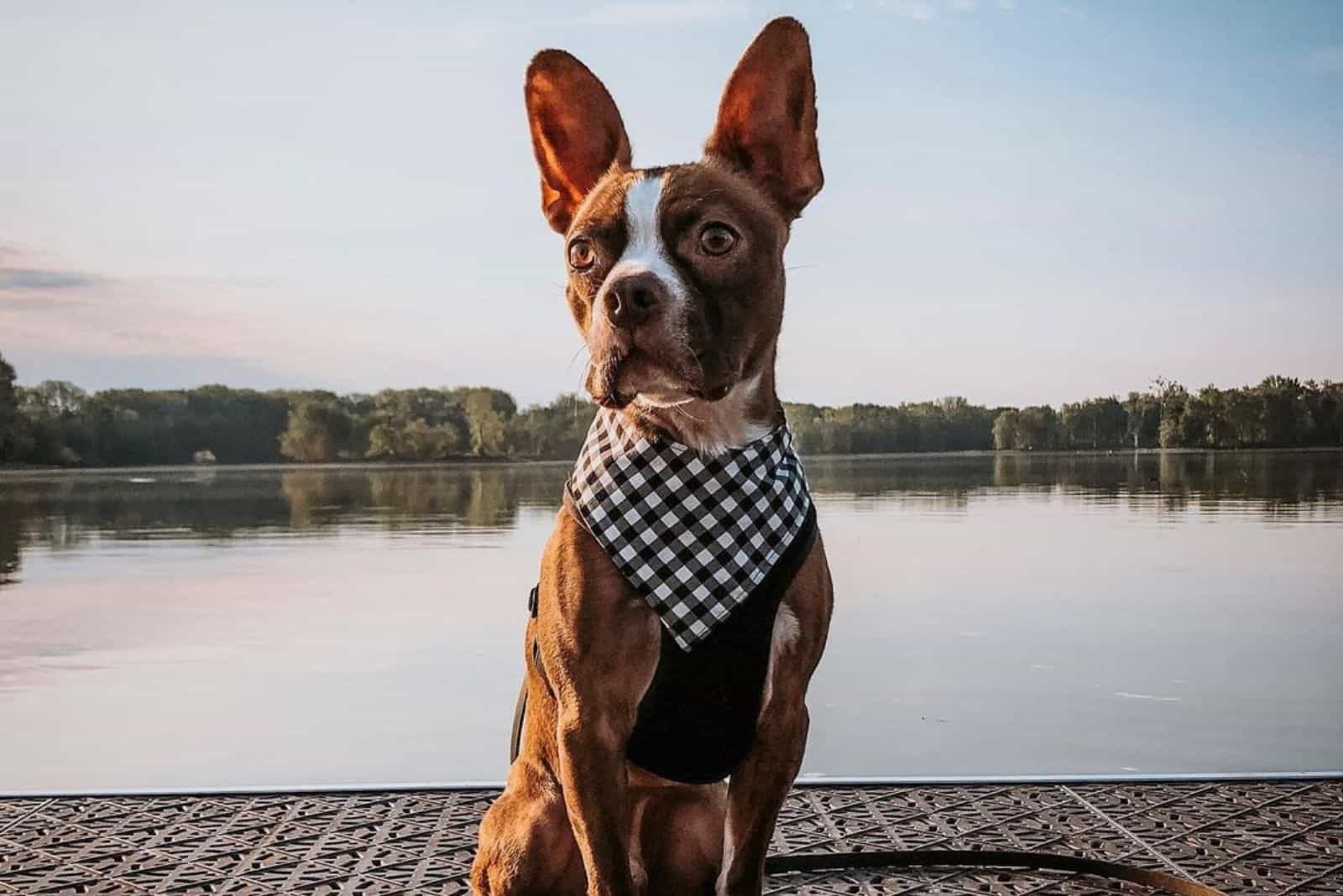The Boston Terrier is one of the most popular dog breeds all over the world. They were originally bred to be fighting dogs, but today, they’re gentle, affectionate companions with tuxedo-like markings that earned them the nickname “American Gentleman.”
The Red Boston Terrier is a “member” of the Boston Terrier dog breed, but one thing distinguishes it from its family, and that’s fur color. However, this breed is the most well-known out of all the non-traditional colors of Boston Terriers.
Do you want to know everything about this dog with its amazing fur color and unique characteristics? Continue reading. But first, let’s see what we know so far about Boston Terriers in general.
Boston Terriers – More About The Breed
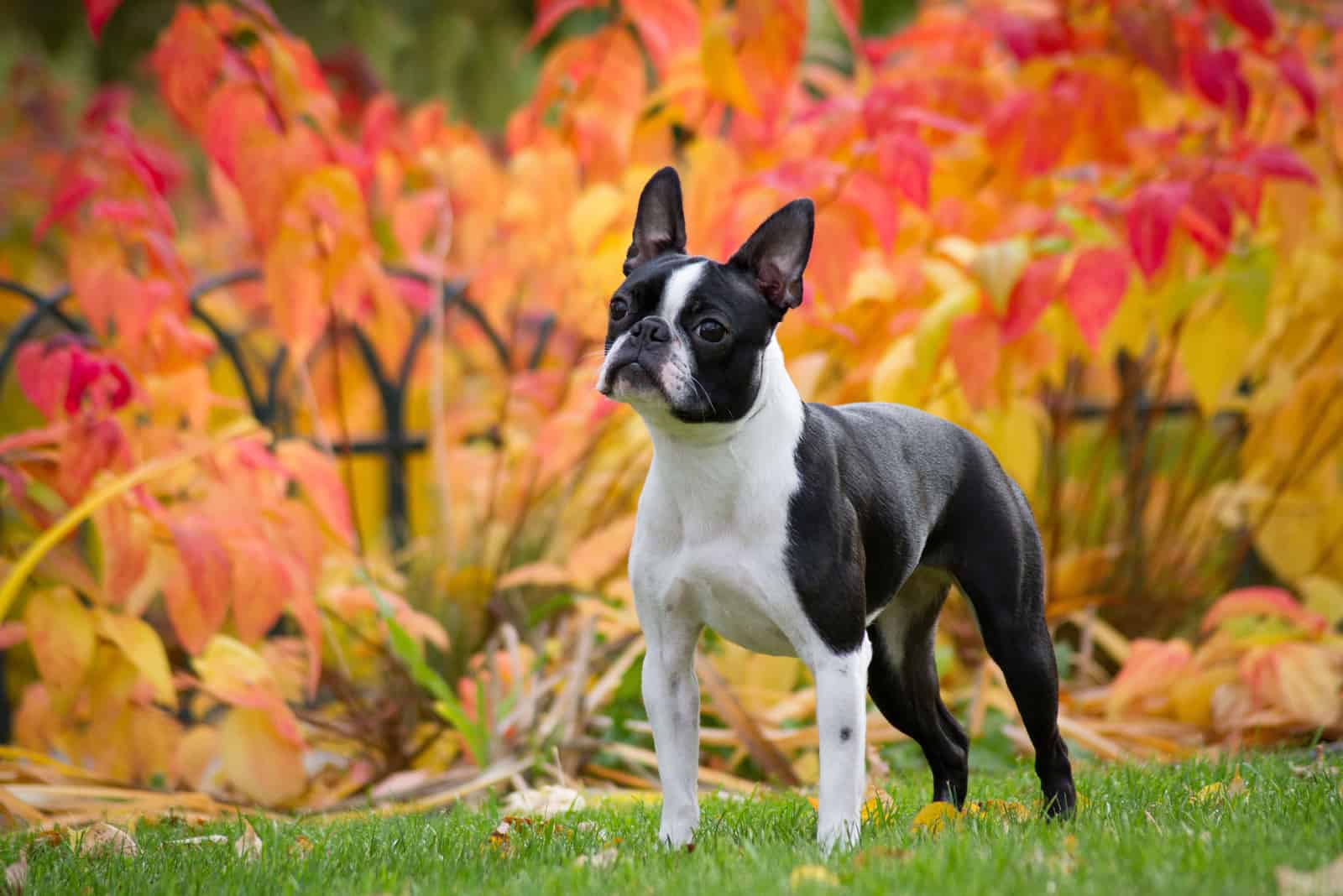
It’s a well known fact that Boston Terriers were bred in Boston, Massachusetts in the late 1800s. There are few stories about their origins. Still the most popular is the one about a dog named Judge.
According to that story, the Boston Terrier descends from a dog named Judge, that was probably a cross between a Bulldog and the now-extinct white English Terrier. Judge’s owner, Robert C. Hooper, bred him with Burnett’s Gyp, and one of their puppies was Wells’ Eph. Eph’s offspring are the ancestors of today’s Boston Terriers.
In 1889, about 30 owners of Boston Bull Terriers formed the American Bull Terrier Club, and they called these dogs Round Heads or Bull Terriers. However, Bull Terrier and Bulldog fanciers objected to the name.
Since the Bulldog contingency had a lot of power with the American Kennel Club (AKC) at that time, the Boston Bull Terrier fanciers decided to change the name of their club to the Boston Terrier Club, in tribute to the birthplace of the breed. People then started referring to the breed as Boston Bulls.
The breed was recognized by the AKC in 1893. The Boston Terrier was one of the first non-sporting dogs bred in the United States and was the first of the ten made-in-America breeds currently recognized by the AKC.
Even though, today, it sounds strange, Boston Terriers actually have been bred to be ferocious pit-fighters. The American Gentleman, as this dog was called in the 19th century, is definitely a lover, not a fighter, although males have been known to show their terrier ancestry with a bit of posturing when they feel as if their territory is being invaded by another dog.
How Big Does A Boston Terrier Get?
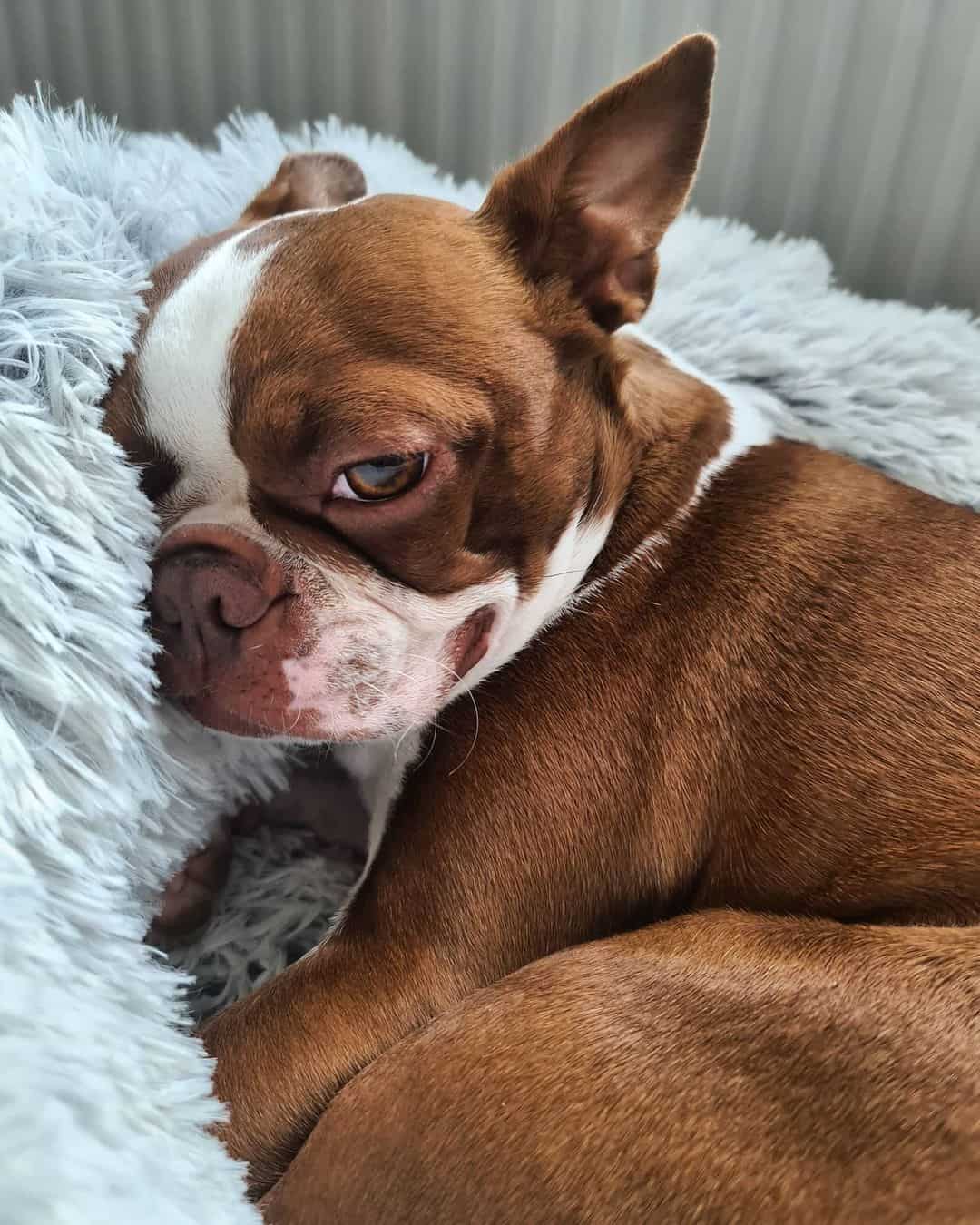
Photo from: @stella_our_bostonterrier
The Boston Terrier is a lively, highly intelligent, smooth-coated, short-headed, compactly built, short-tailed, well balanced dog. It is brindle, seal, or black in color, and evenly marked with white.
The head is in proportion to the size of the dog, and the expression indicates a high degree of intelligence.
This dog typically stands 15 to 17 inches tall at the shoulder, and weighs between 12 and 25 pounds.
The Boston Terrier should do well on high-quality dog food, whether commercially manufactured or home-prepared. Some dogs are prone to getting overweight, so watch your dog’s calorie consumption and weight level.
What Is The Lifespan Of A Boston Terrier?
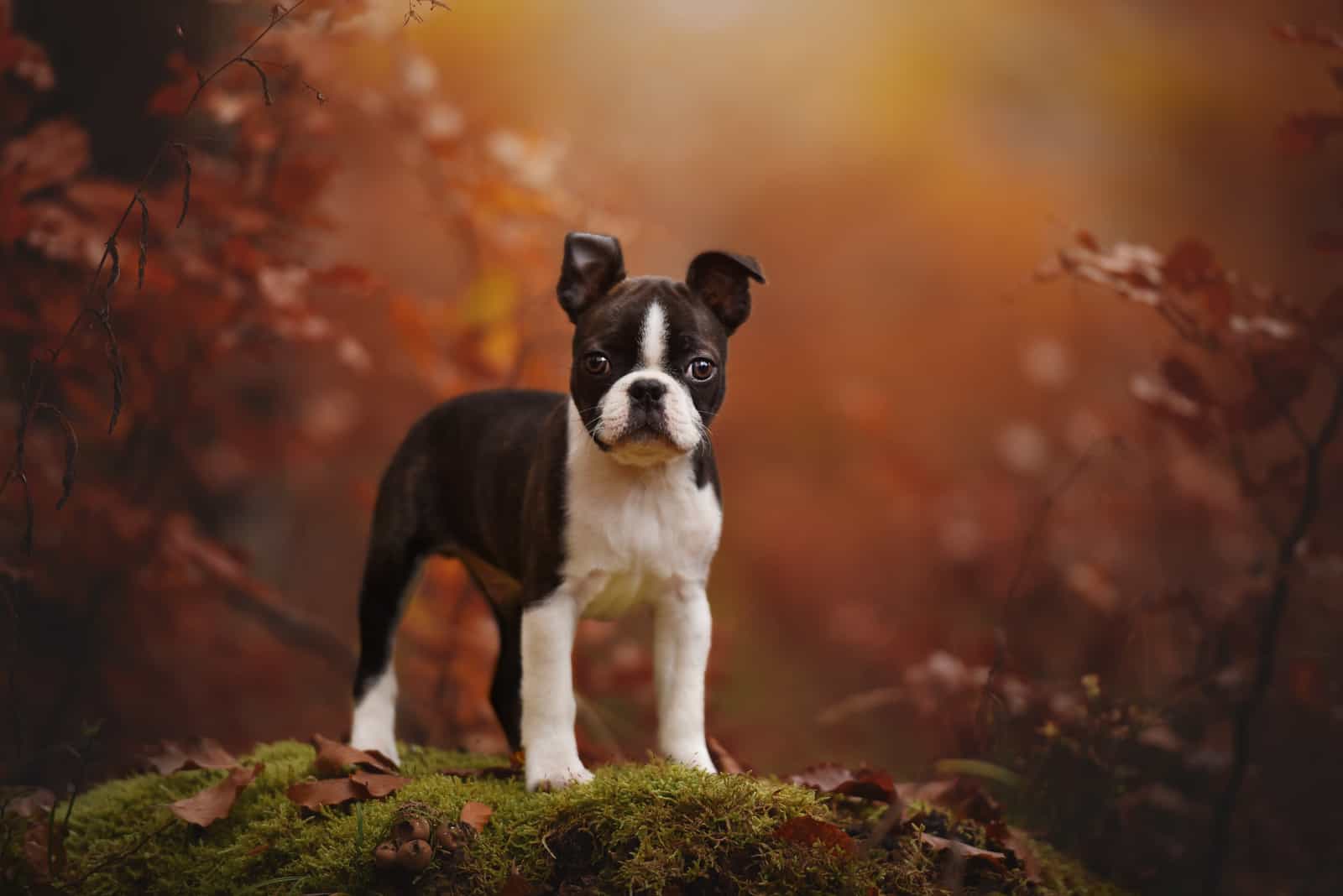
The Boston Terrier’s lifespan range is between 11 to 13 years. Some Boston Terriers can live for longer (15 years) or shorter depending on diet, environment, lifestyle, and genetics.
Compared with similar-sized breeds, the Boston Terrier lifespan falls below average and simply isn’t long enough. The fact is that some dogs die a lot younger, and others live to a ripe old age.
You can increase a Boston Terrier’s life expectancy with the following tips:
– Choose the right breeder
– A healthy diet (quality dog food)
– Control your dog’s weight
– Regular exercise
– Health care (go to the vet for regular check-ups)
Boston Terrier – Traditional Colors Description
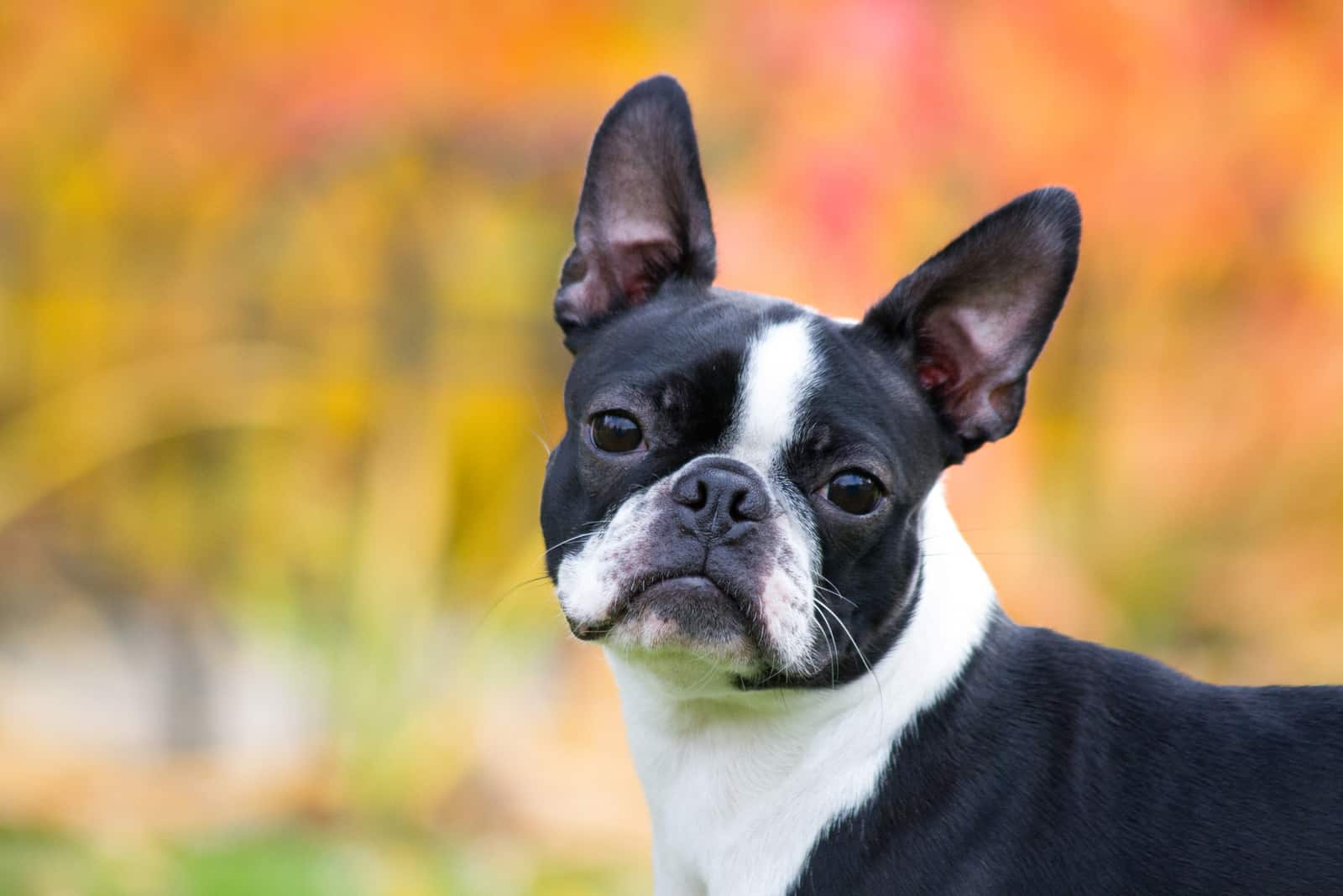
In the early days, the breed’s color and markings weren’t considered to be very important. Additionally, although the dogs being bred met the standard outlined by the club, there was a lot of inconsistency within the breed.
After years of careful inbreeding to set the type, the Boston Terrier as we know it today was developed. In the 1900s, the breed’s distinctive markings and color were written into the standard, making them an essential feature of the breed.
According to AKC’s standards, the following are the qualified colors of the breed:
• Black and White
• Black, Brindle, and White
• Brindle and White
• Seal (black, with a red cast in bright sunlight) and White
• Seal Brindle and White
The newest version of the AKC breed standard also goes into detail about ideal and accepted white markings. The best places for Boston Terriers to display their signature white markings are as a chest splash, a blaze between the eyes, and a muzzle band. It is acceptable (but not ideal) to show white on the collar and legs (hocks).
In this section, we take a closer look at the most common Boston Terrier colors:
• Black and White – this is the coat color that gives the Boston Terrier that dignified “tuxedo” look, responsible for the breed’s nickname, “American Gentleman.” With this coat color, black predominates and white is an accent color. In order to be true Boston Terrier colors of black and white, the eyes will be dark brown and the nose will be black.
• Brindle and White – The brindle coloration is technically a pattern of markings rather than a solid (self) coat color. Brindle can vary from dark to light, and the base can be dominant or dilute.
A dilute color is a recessive form of a dominant color such as black or brown. For example, a dilute black might appear to be blue or lilac while a dilute brown might appear as red. It is important to know that true Boston Terrier colors, brindle and white, will also have dark brown eyes and a black nose.
• Seal and White – The seal and white coat color is often referred to as brown and white. This is an acceptable Boston Terrier coat color if you want to show your dog or breed to AKC show standards in the future.
Seal can be a difficult color to pinpoint for those who are new to the Boston Terrier breed. This color looks solid black until the light hits it in a certain way to bring out red undertones. A true seal-and-white Boston Terrier will also have dark brown eyes and a black nose.
When most people think of Boston Terrier colors, they automatically think of the ones we just mentioned. So, it can be a surprise to learn that there are more Boston Terrier colors as well! Let’s meet the red Boston Terrier.
Red Boston Terrier – Basic Info
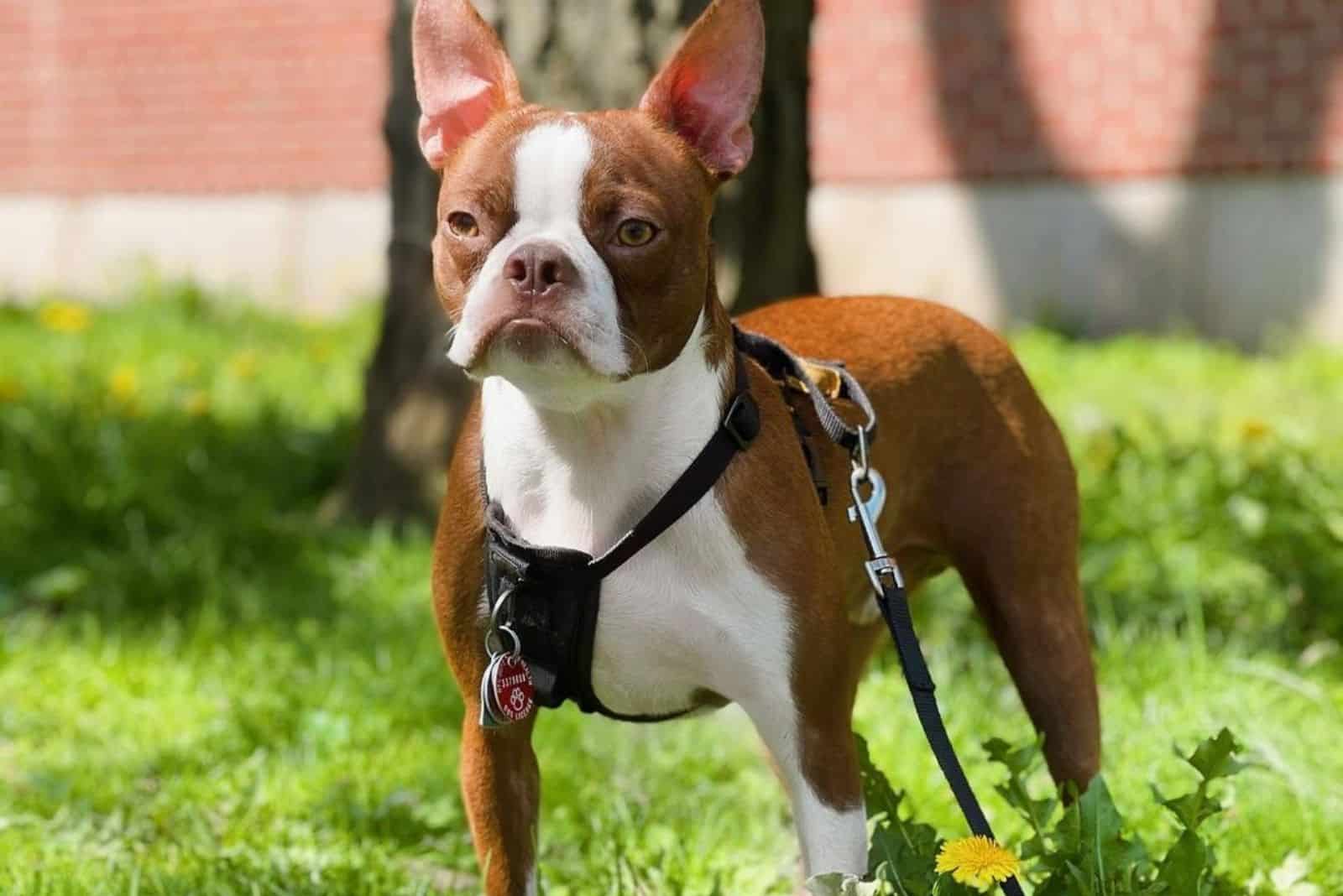
The red Boston Terrier came from the variation of Boston Terriers. It traces its origin back to 1865, to a cross between an English Bulldog and an English Terrier. The first thing you notice about these dogs is their different color coat; red fur coloring, which is considered non-standard for its breed and makes them distinct from other Boston Terriers.
Let’s check the table with red Boston Terrier basic information:
[table id=73 /]
The red coat of this canine resembles a liver-toned hue. Many non-reputable breeders earn hefty amounts by claiming that this color is ‘rare.’ This type of colored Boston terrier is actually not that rare and, in fact, is popular with Boston Terrier enthusiasts as well!
The term “Red Boston Terrier” is mostly used as a marketing ploy to allow breeders to charge extra for their dogs, even though the red coloration isn’t any rarer than the regular black-and-white coloration.
However, this coloration (also described as liver color) is not recognized by many organizations. More about this later.
Red Boston Terriers are exactly like regular Boston Terriers, only they have a red coloration. They are not technically a separate breed, and are extremely similar in terms of temperament. The only difference is their coloration.
These adorable dogs are fond of human interactions, too. That being said, they make a great companion towards anyone.
The red Boston Terrier may be unique to its kind, but it is still confused with the similarly-looking French Bulldog and Boxer. Let’s see what we know about this dog’s physical appearance.
Red Boston Terrier – Physical Appearance
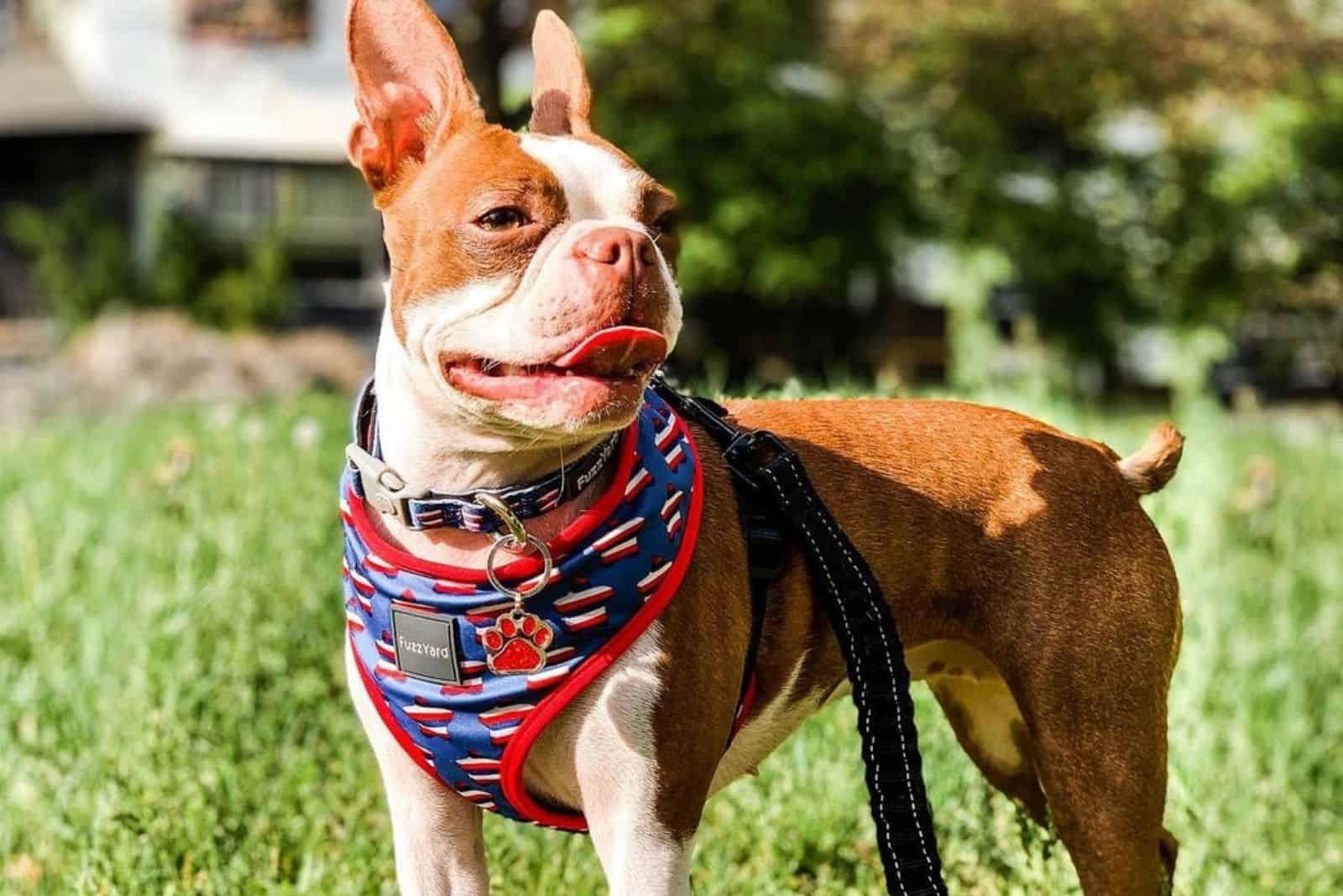
The Red Boston Terrier is compactly-built, 15 to 17 inches in height, and 12 to 25 pounds in weight. This dog belongs to a family of brachycephalic dogs (e.g., English Bulldogs, French Bulldogs, Pugs, Boxers, Shih Tzus, and others), which are breeds with shortened snouts.
Here is what the red Boston Terrier looks like:
• Facial structure: It has a flat skull structure, a short head, and a square jaw. The head is in proportion to its size.
• Coat: It has an adorable red carpet ready look, thanks to its tuxedo-like coat. In this color, there is a varying shade of copper red to vivid red. White markings are present in the chest, between the eyes, and around the muzzle.
• Nose: The nose of a genuine red Boston Terrier is reddish-brown, and it matches its paws.
• Eyes: The large, almost-pleading eyes are set widely apart. Red Boston puppies can have blue eyes, but this usually changes into amber when they reach four to six months old.
• Ears: Their large cat-like ears stand erect. They are small in size and placed on the corners of the skull, naturally making the shape of the head as square as possible.
• Muzzle: The muzzle is short and deep, square-shaped, and wrinkle-free. On top of its flat cheeks, this gives a pushed-in facial appearance.
• Body: The body is short but sturdy and muscular. It has a broad chest, a short tail and limbs, and a generally pugnacious stance.
As you can see, aside from its color, the red Boston Terrier is not very different from the other Boston Terriers. It is only distinguishable due to its appearance. Usually, the standard Boston Terrier has dark-colored eyes, but the red-coated one has amber or gold.
We already mentioned the difference in fur coloring. But, if we’re talking about a purebred red Boston Terrier, it must possess the same appropriate white markings and inhibit similar traits as the other Boston pups.
The Breed Standard: Do Kennel Clubs Recognize Red Boston Terriers?
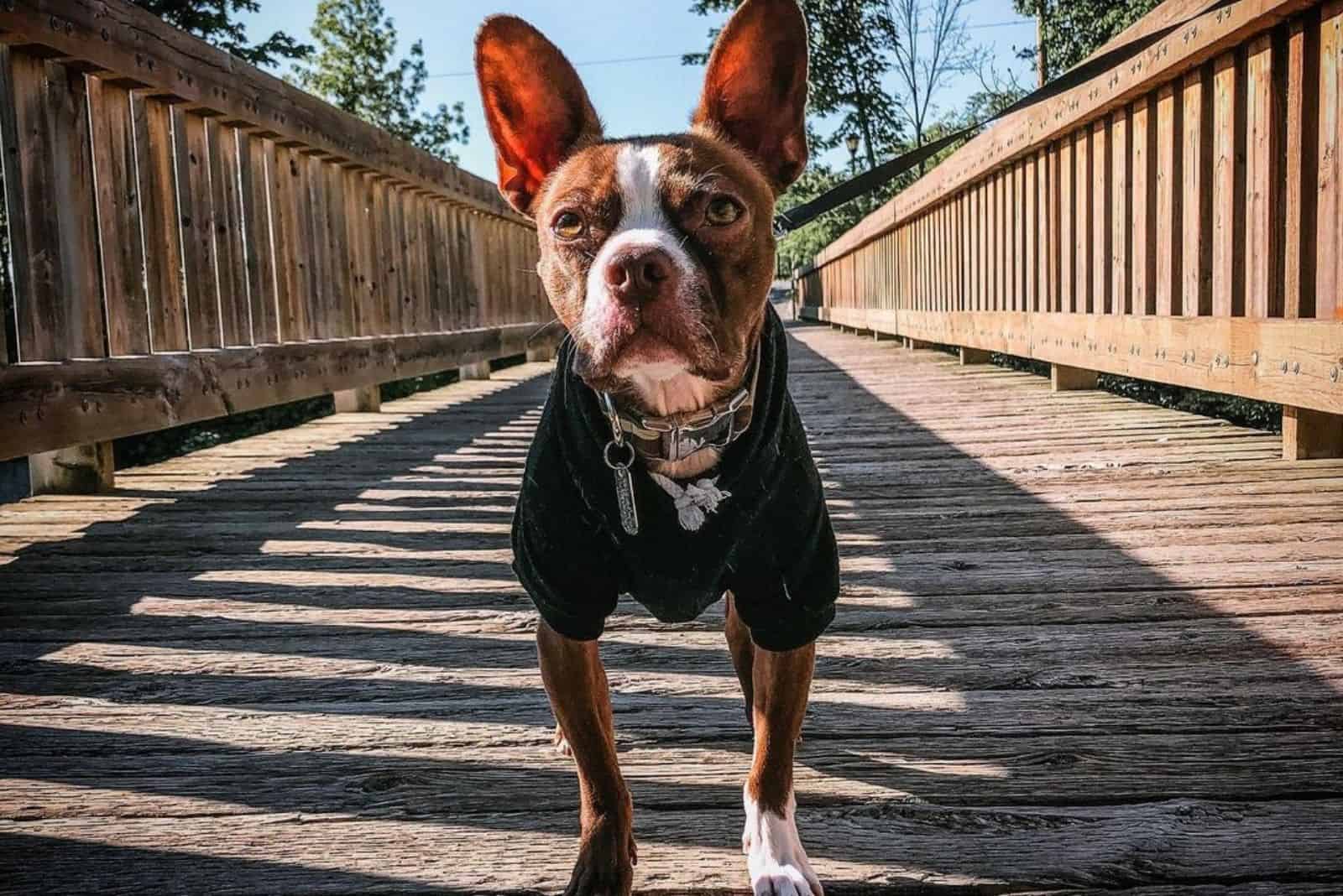
Unfortunately, the Boston Terrier Club of America and the AKC don’t recognize the red-coated Boston as a breed standard.
The AKC has some standards based on which a dog is registered with the club. This club determines an original Boston Terrier according to a set of points, including the general appearance, expression, and individual body parts.
The red Boston Terrier falls short on some of the categories. It does not qualify under the dark-colored eyes and black-colored nose criteria; therefore, it could not participate in AKC dog shows.
Quite unfair, we know!
So, what does this mean? This just means that you can’t go to AKC- (or other kennel club) sponsored events or competitions with your dog. As they can’t be registered with the AKC, this does not necessarily mean that red Boston Terriers aren’t great dogs!
Red Boston Terrier Genetics
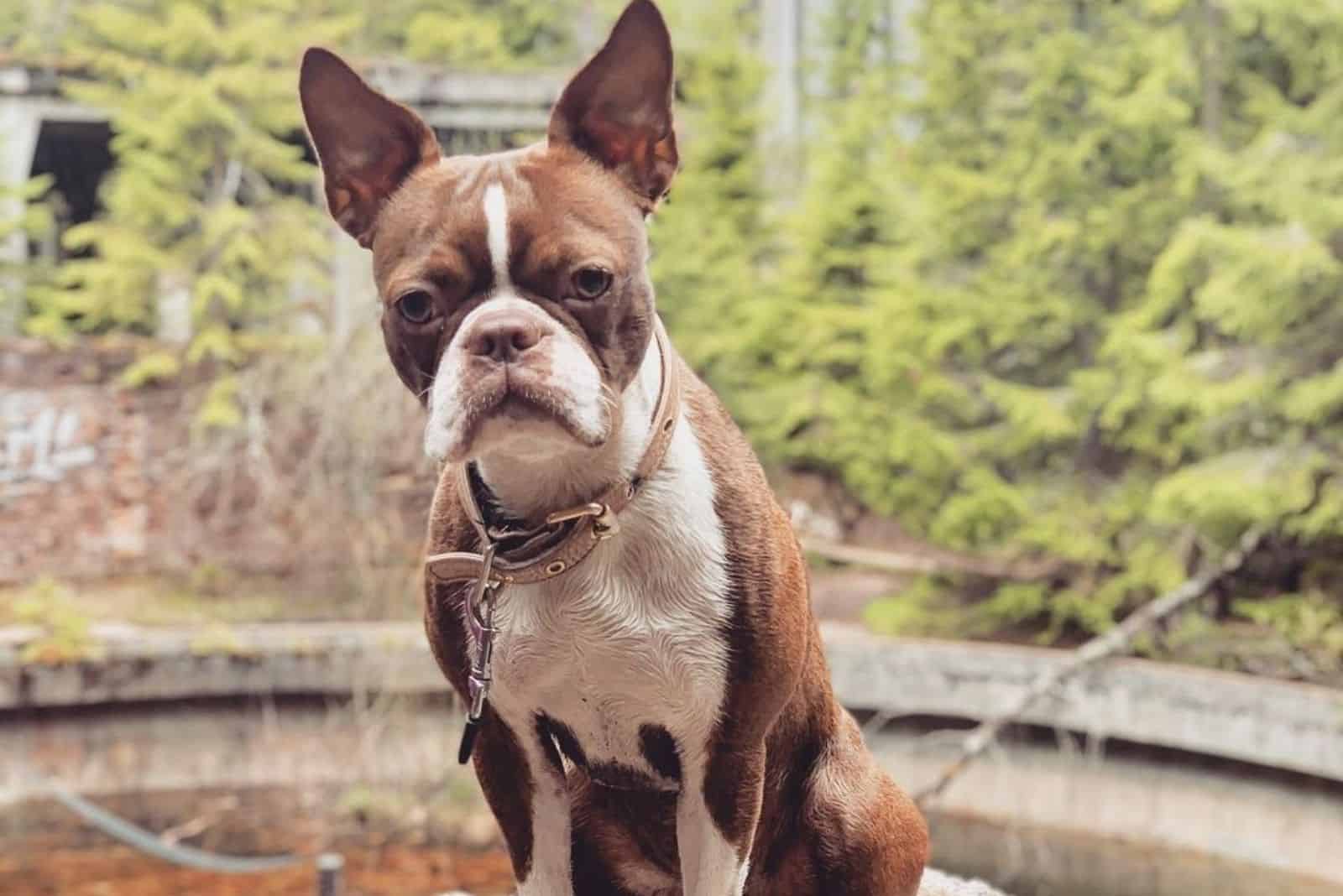
What coat color a dog will have greatly depends on its genetics. There are two major pigments that determine the coat color:
• eumelanin (black pigment), and
• phaeomelanin (yellow/red pigment)
The genes control each of these two pigments. It dictates how much of the pigments are produced, and where these pigments are produced.
The red canine coat is produced when the gene (e) stops the production of the black pigment until what’s left is the production of the red pigment. A dog with two copies of the gene (e) will pass it on to 100% of its offspring. Since the red Boston Terrier traces its forefathers to the Bulldog and the White English Terrier, its red coloration can be linked to the Bulldog lineage.
Since the red color of these small dogs is a product of genetic mutation, many people believe that these dogs are more prone to health problems simply because they look different. But, this is a myth that has been disproved over the years.
On the other hand, there is concern about hair loss, skin problems, allergies, and even deafness in Blue Boston Terriers and other rare-colored Bostons. Albino Boston Terriers, for instance, can have higher cases of skin allergies and irritations. Also, their risk of sunburn seems to be higher.
However, this is not the case with the Red Boston Terrier – there are no known health and behavioral defects related to its color.
Red Boston Terrier Puppies – How Much Do They Cost?
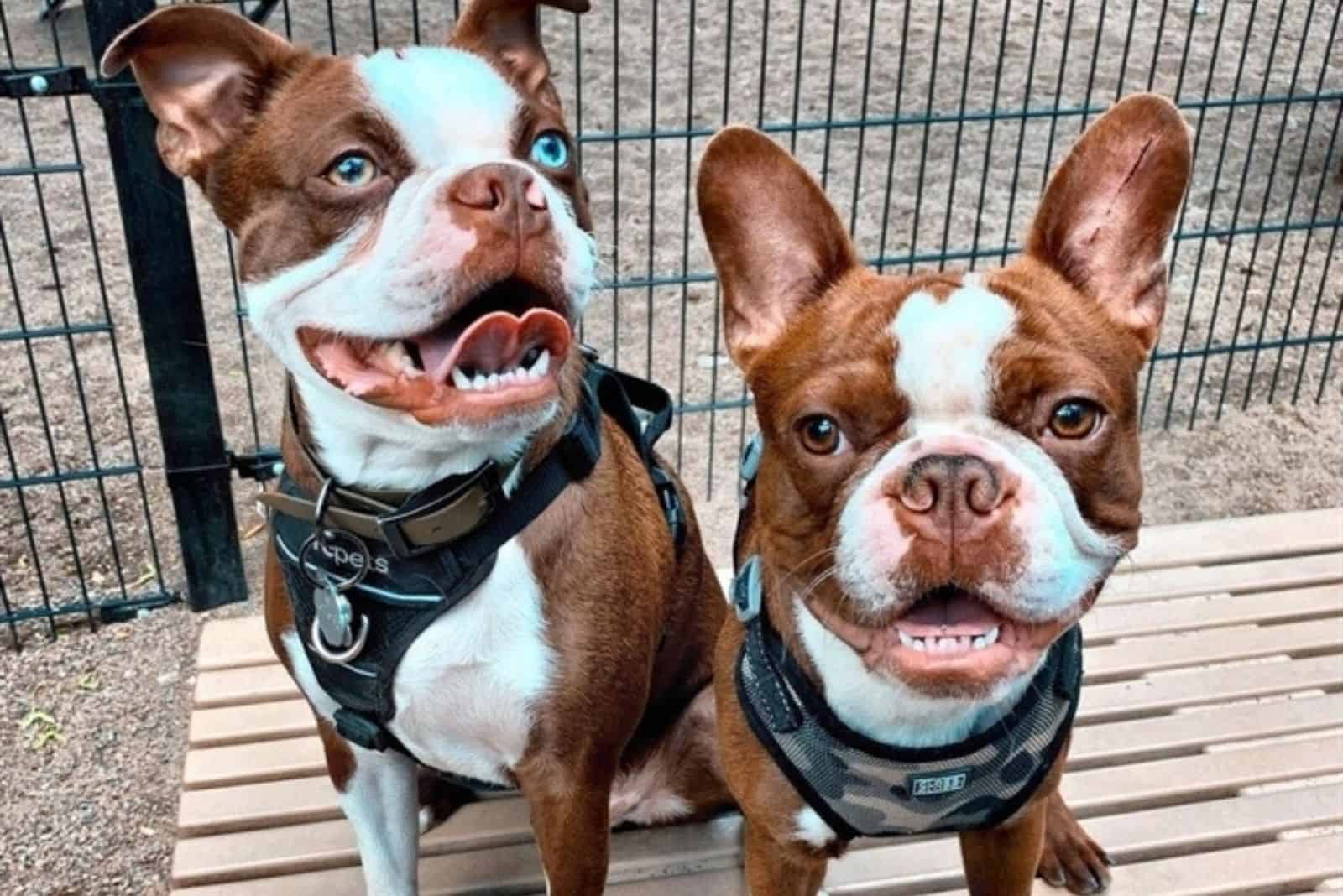
Red Boston Terriers should not be more expensive than a standard Boston Terrier. Some breeders may try to sell them at a heightened price and claim that they are “rare”, but don’t fall for that.
The price of these puppies can be anywhere from $600 to $1,200 (average price is $989).
The general cost of Boston Terriers ranges from $350 to $4,000. The cost grows significantly higher for a top-quality dog with superior lineage. Other factors such as the age, health, and gender of a dog, as well as the breeder’s certification, are also price indicators.
Read Also: Best Boston Terrier Breeders In Ontario To Buy A New Pet From
Red Boston Terrier’s Personality
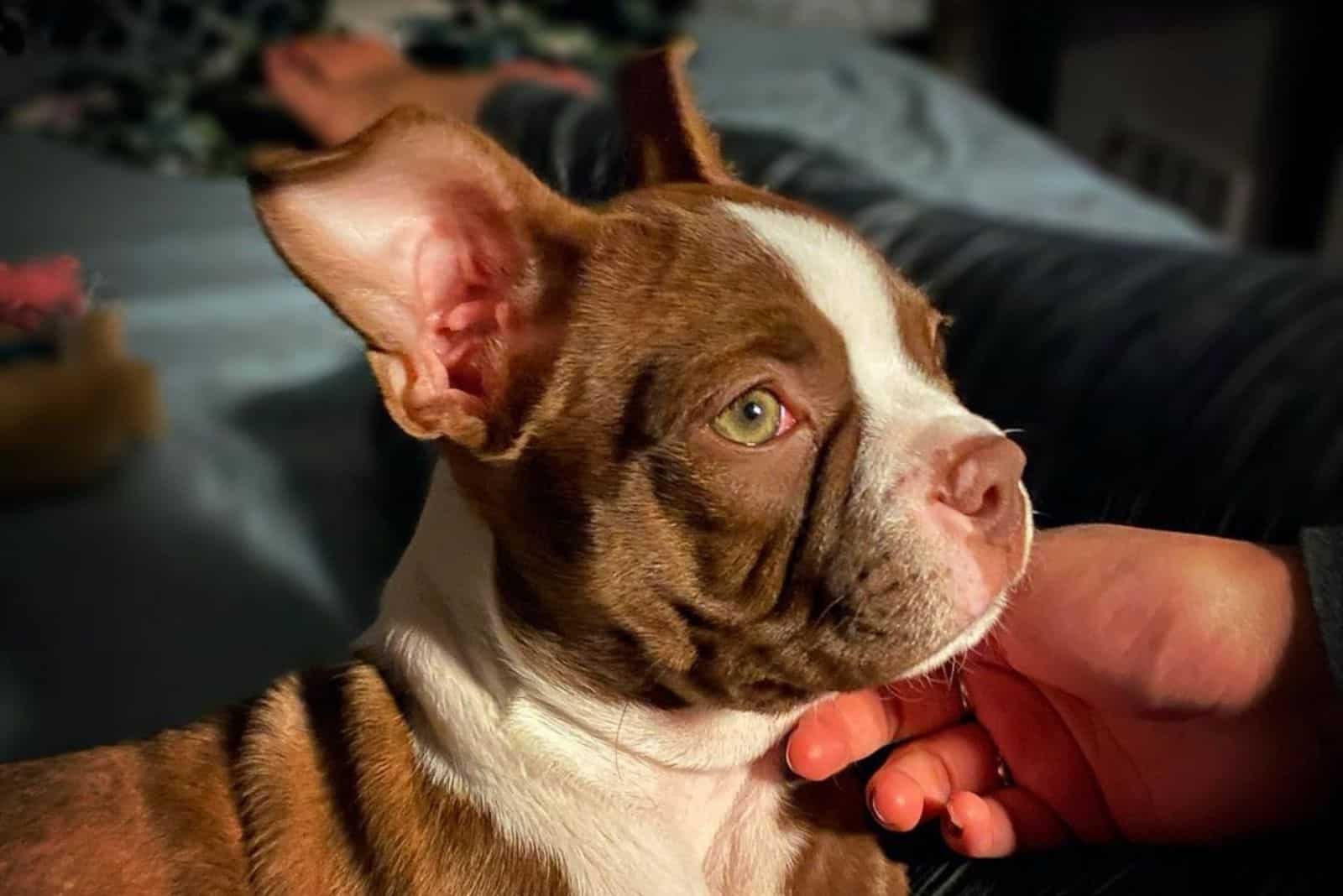
Red Boston Terriers are very adaptable, and can live in homes or apartments as long as they are protected from extreme heat or cold. They enjoy being around people, whether they know the person or not.
You can take them for a walk and expect them to have an interest in everyone like people walking past, sitting beside, moving, etc. – they are a people-oriented breed.
These pooches are gentle, but may not necessarily be great with small children because they can be easily injured. They are sometimes protective of their owner, and sometimes tend to be a bit clingy.
Red Boston Terriers are extremely intelligent, affectionate, and have a cool temperament. However, without proper training, they can become stubborn, so persistence and consistency are definite musts when training.
Most Red Boston Terrier owners also commend the dog’s easy-to-train attitude, but each dog is an individual. Some are more amenable to training than others. If your dog seems unwilling to get with the program, try to figure out what motivates it. Usually food works, but praise or a favorite toy may also be the key to successful training.
Red Boston Terriers are very cuddly, sensitive, and rarely aggressive. They tend to be hyperactive, too, which requires constant exercise. Despite being smaller dogs, they have a lot of energy and need to play and take walks daily. However, as mentioned above, they have a problem with overheating, so you better make sure that they don’t overexert themselves when playing outside!
However, because they are smaller, they do not need as much exercise as larger dogs. They can function in a city very well as long as you walk them regularly.
Simply letting this dog out into the backyard doesn’t count as exercise – it’ll probably just sit at the door waiting to be let back in. Left alone for long periods of time, a Boston will tend to become frustrated and develop undesirable behaviors. Throw it a ball or a toy, however, and it’ll be more than happy to play with you.
As with all breeds, early socialization is recommended. Socialization – gently exposing the puppy to a wide variety of people, places, and situations – will help your dog develop into a well-adjusted, well-mannered adult. Treats make a great training incentive.
Many red Boston Terriers are quite sensitive; for them, gentle corrections should be followed by warmth and praise.
Grooming: Taking Proper Care Of Your Red Boston Terrier
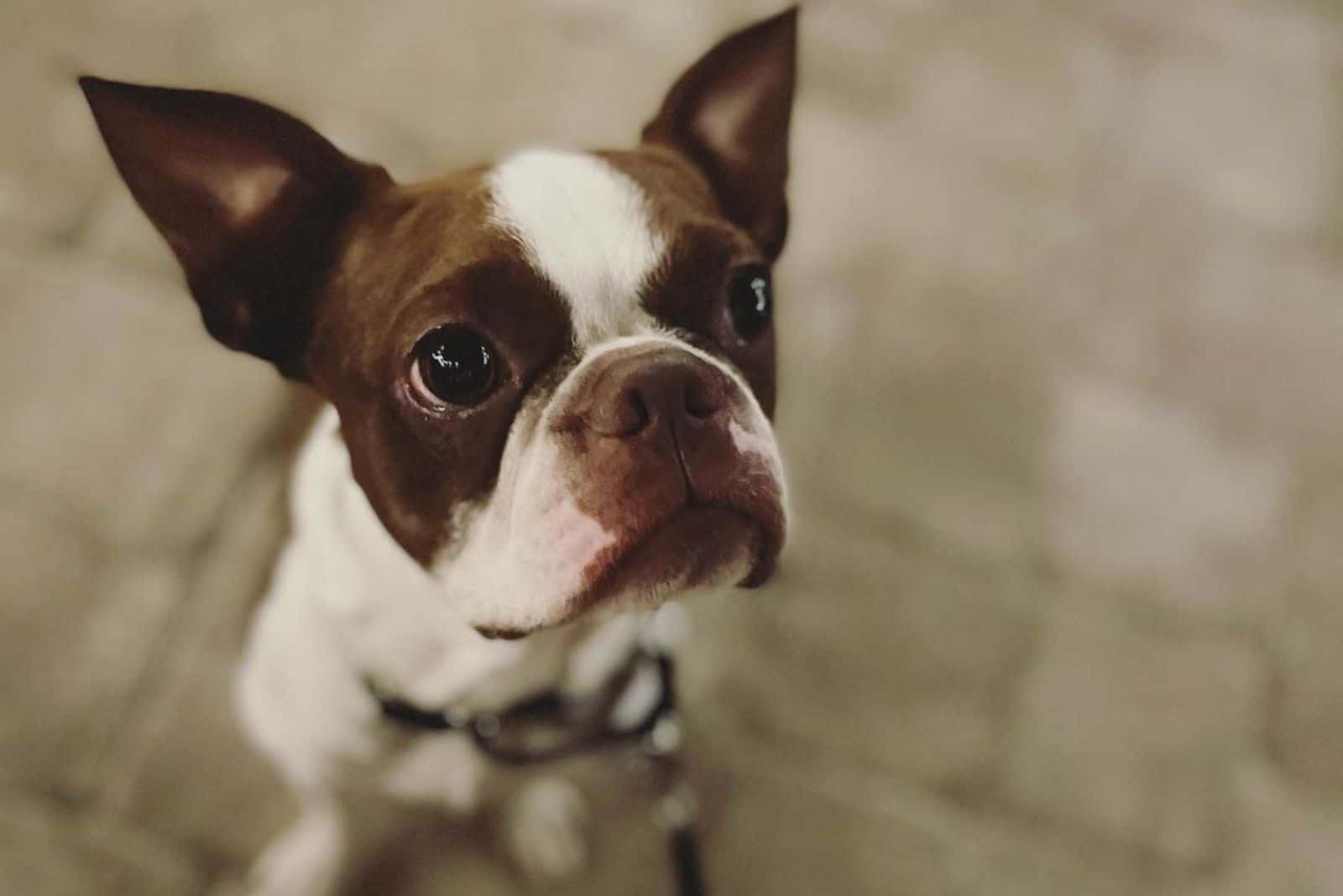
Red Boston Terriers are easy to groom. Although they do shed, it’s minimal and should be easily controlled by regular brushing. Brush them weekly with a firm bristle brush, and give them an occasional bath when necessary.
Because their eyes are so large and prominent, you should wash their faces every day, and check their eyes for signs of redness or irritation.
Brush your dog’s teeth at least two or three times a week; daily brushing is even better if you want to prevent gum disease and bad breath.
Trim the dog’s nails once or twice a month if your dog doesn’t wear them down naturally in order to prevent pain and other problems. If you can hear them clicking on the floor, they’re too long. If you’re not experienced with trimming dog nails, ask a vet or a groomer for pointers.
Red Boston Terrier ears should be checked weekly for redness or a bad odor, which can indicate an infection. When you check your dog’s ears, wipe them out with a cotton ball dampened with gentle, pH-balanced ear cleaner to help prevent infections. Don’t insert anything into the ear canal; just clean the outer ear.
Begin accustoming your red Boston Terrier to being brushed and examined when it’s a puppy. Make grooming a positive experience filled with praise and rewards, and you’ll lay the groundwork for easy veterinary exams and other handling when your dog is an adult.
Red Boston Terrier: Food And Diet Requirements
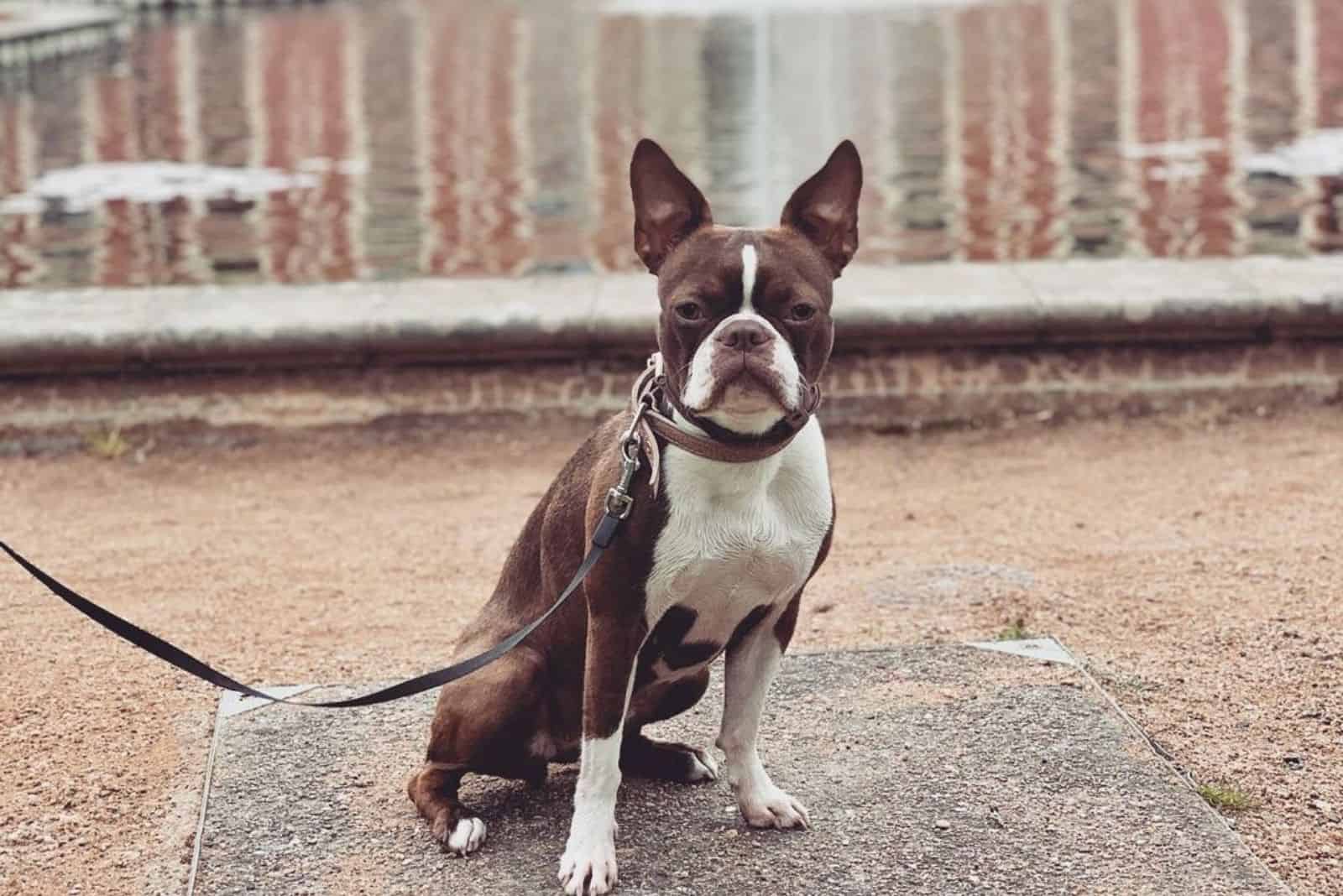
How much your adult dog eats depends on its size, age, build, metabolism, and activity level. Dogs are individuals, just like people, and they don’t all need the same amount of food.
As small dogs, Red Boston Terriers don’t eat very much. Because of this, it is easier to feed them high-quality dog food than it is a larger dog, such as a Great Dane, for example. They eat less, so you can often afford to feed them a bit of a higher quality food than you may your large dog.
These dogs can eat any commercial dog food. Because of their common health problems, you may want to feed them a particularly high-quality dog food. Of course, there is no guarantee that the food will prevent health problems, but it can’t hurt!
See Also: Boston Terrier Feeding Chart: The Bostie’s Diet Info
Male Vs. Female Red Boston Terrier: Is There Any Difference?
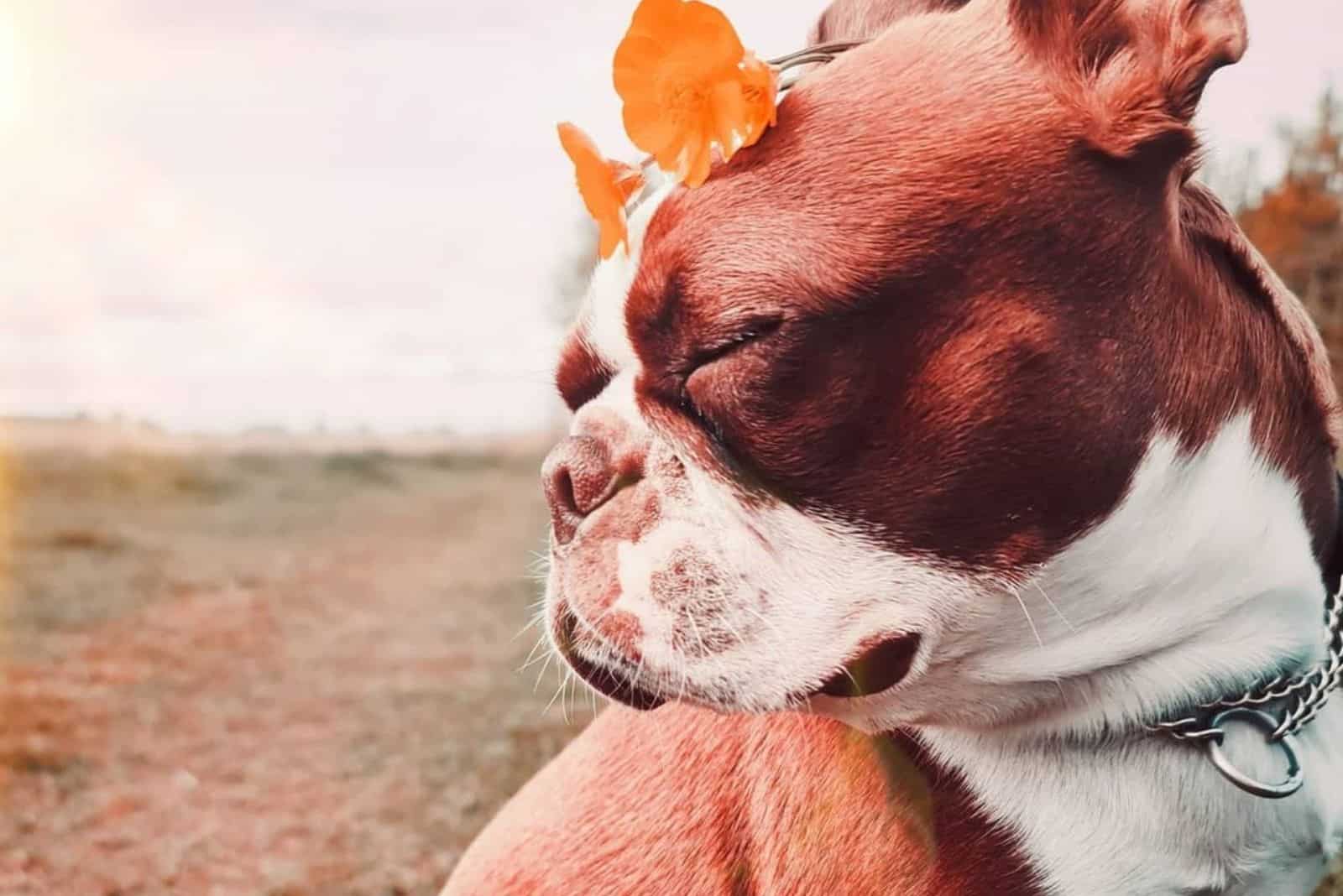
Both male and female red Boston Terriers are excellent companion dogs. There is not much difference between them.
Male red Boston Terriers are slightly taller than females; they grow up to 17 inches, while females grow up to 15 inches. They are heavier, too. Adult males weigh around 10 to 25 pounds, while females weigh 9 to 20 pounds.
When it comes to temperament, there are some differences. The female red Boston Terrier matures faster than its male counterpart. Females also tend to be more dominant, bossy, and territorial while males are more friendly and affectionate. Due to their quick maturity, females are considered to be more intelligent and easier to train.
On the other hand, males can be a little bit stubborn. They can also show a dominant personality when they feel their territory is being invaded by another dog.
Are Red Boston Terriers Good Family Dogs?
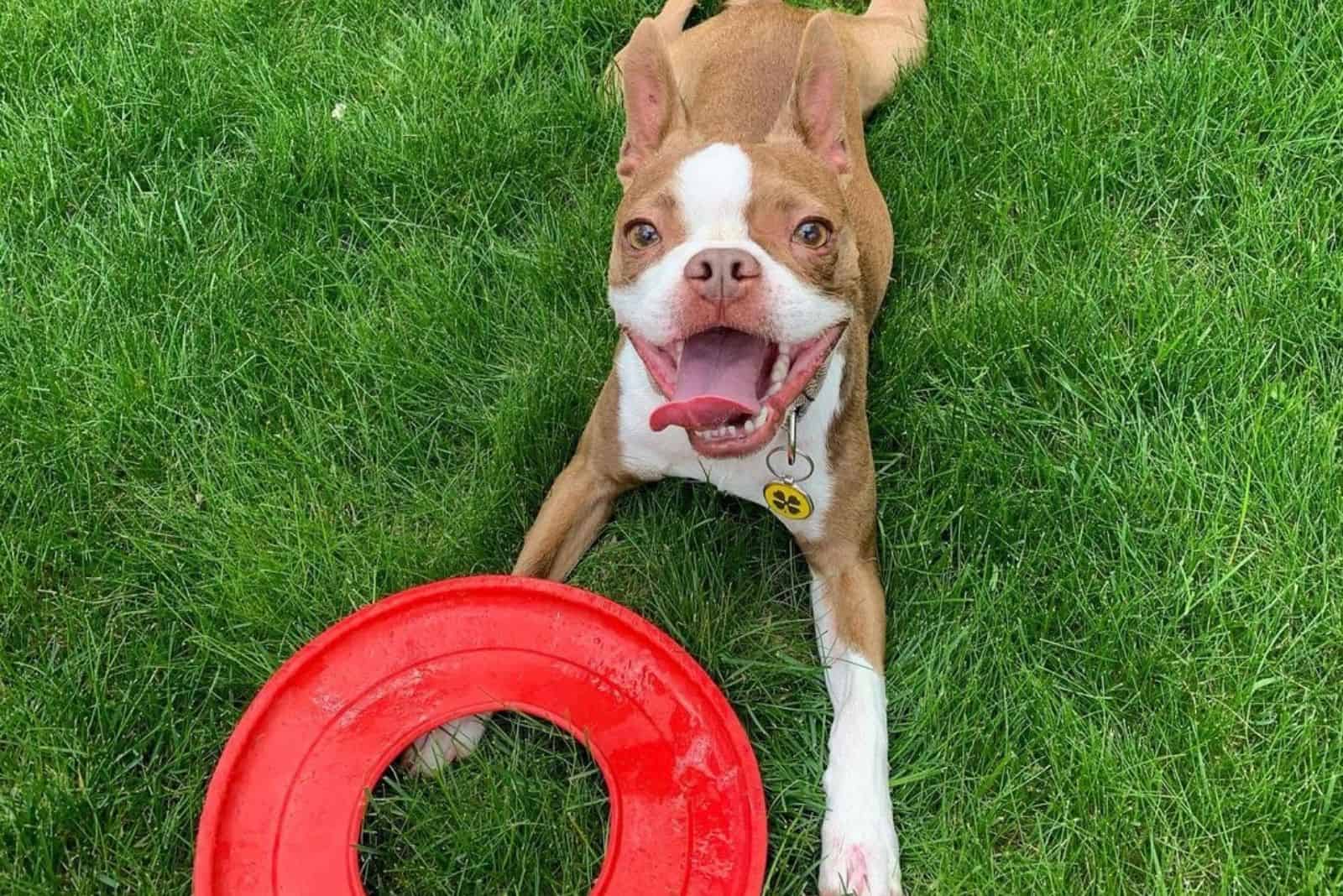
Yes, they are, but of course, when they are socialized properly. They love children and amuse people of all ages with their adorable appearance. They are especially good companions for older people and apartment dwellers.
Red Boston Terriers are perfect for an active family. They love to play fetch, and are great at things like agility training – even if you don’t plan on competing.
We already mentioned that these dogs are well-known for their people-oriented nature. They are curious, but very alert, and can be a bit noisy. However, they are not nearly as yappy as other dogs.
Furthermore, these dogs are sturdy, but they are also very small. Toddlers and young children can easily hurt them if they are not used to being gentle with animals. This can result in snapping and biting.
Unfortunately, children are not able to interpret the dog’s language, nor is the dog capable of communicating in any other way. Therefore, almost all dog bites are a result of failure on the parents’ part to recognize and prevent potential problematic situations.
This does not, however, completely take the blame away from the dog. Dogs are capable of learning to control their behavior and not bite, and older children can learn to ‘leave the dog alone.’
However, when a dog bite occurs, the blame should rest with the adults for failing to prevent it, and the child and dog should not be punished for acting like children or dogs.
A dog and a small child should never be left alone. Even the oldest, sweetest, most passive dog, and the best-behaved child cannot completely be trusted alone. That’s why they should always be supervised with children.
Are Red Boston Terriers Good With Other Dogs And Pets?
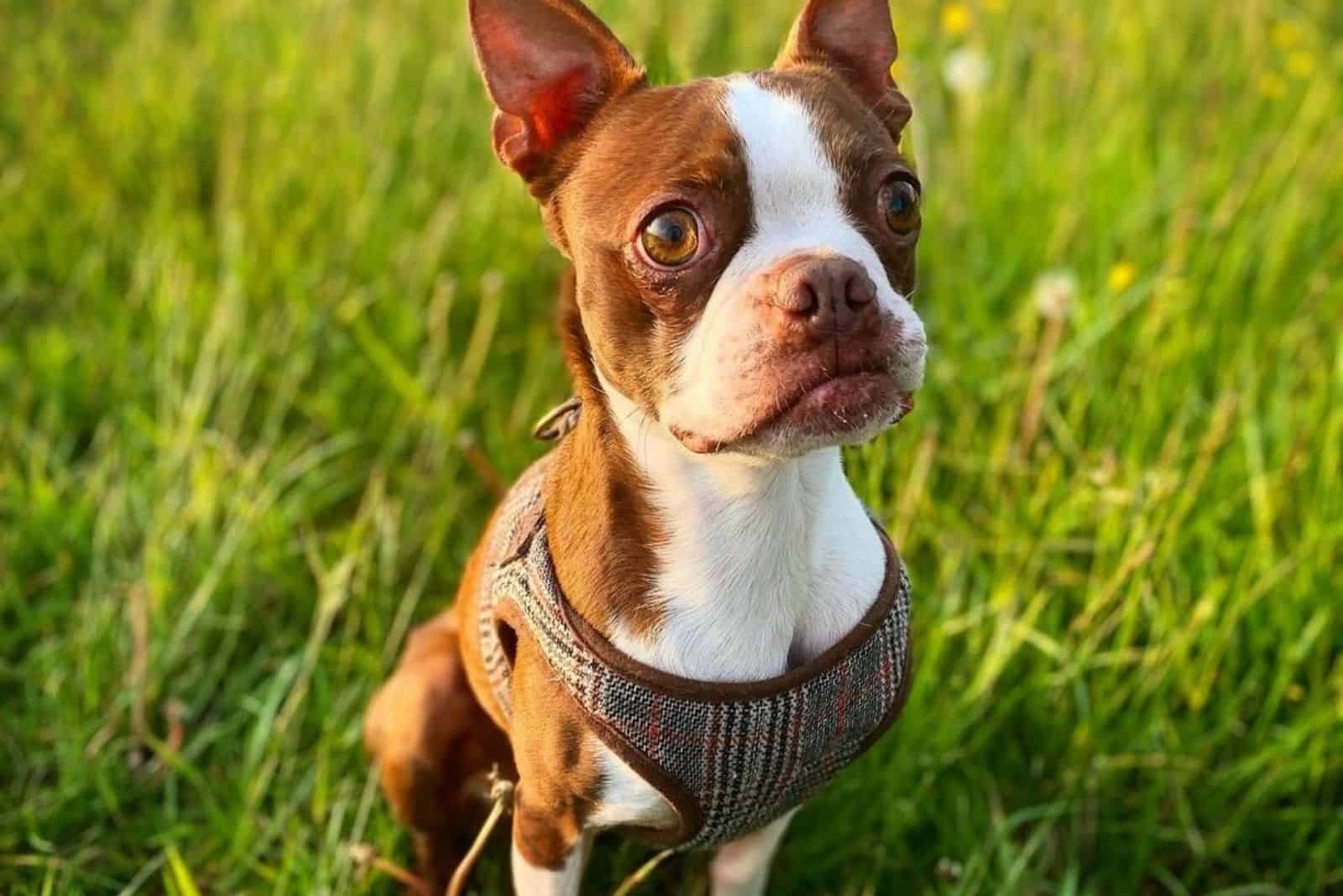
The Boston Terrier does not have strong prey instincts, and because of this, they usually will not chase cats or other small animals. So, it’s not unusual to find your dog napping with the family cat.
They are not particularly friendly to other dogs, and are not pack-oriented. However, if they are raised with other canines, they tend to be friendly towards them. If you work all day, it can be nice to have a second Boston so they can keep each other company.
They can be a bit protective of their owner, which is something you’ll need to keep in mind when introducing new dogs into your household. However, they are often not protective against dogs they grow up with. If you socialize them with a wide variety of canines when they are young, they will often turn out friendly.
The Red Boston Terrier: Health Issues
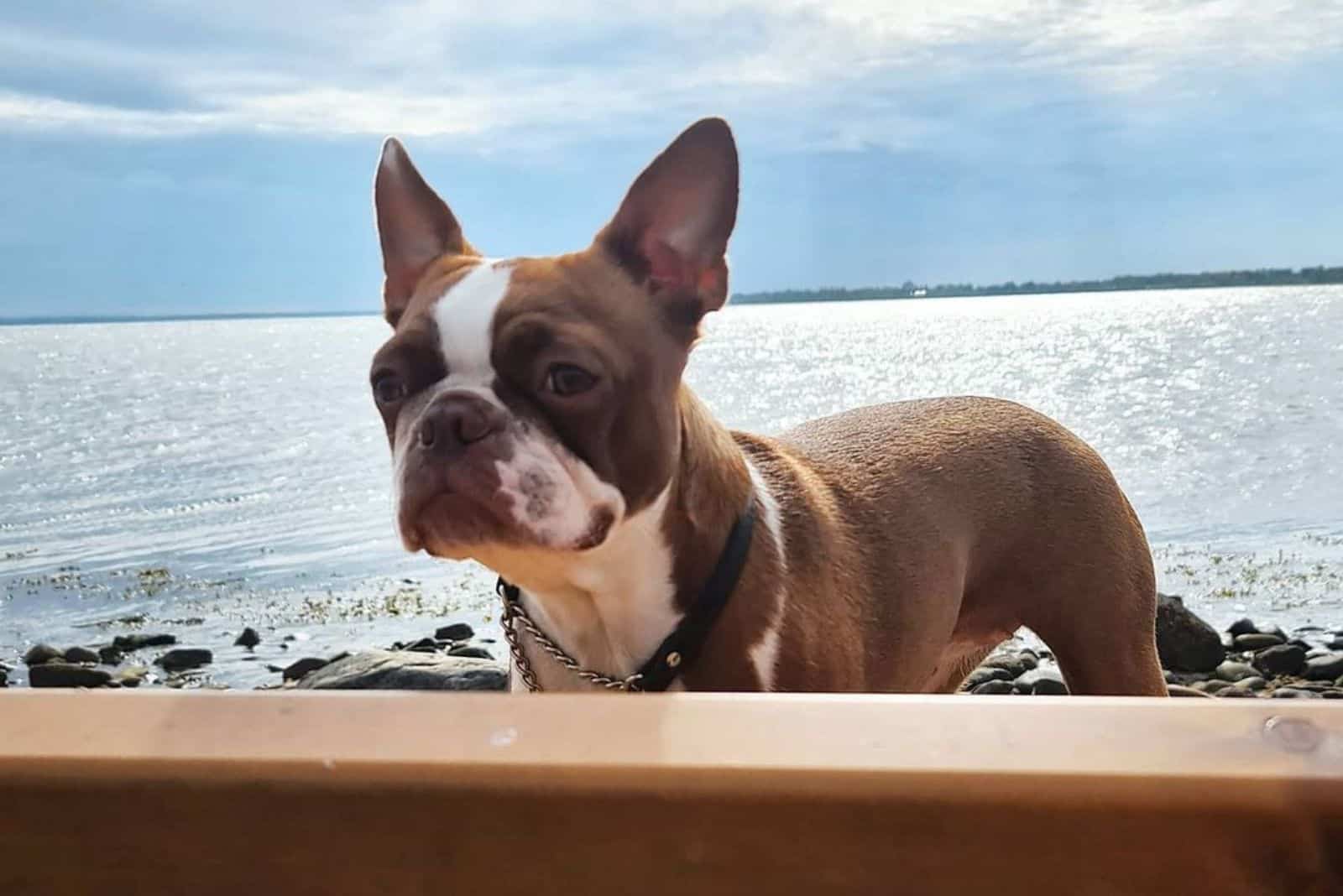
No medical concerns are specific to these dogs (just because the red Boston Terrier has a non standard color doesn’t automatically mean it’s less healthy).
These dogs are generally healthy, with an average lifespan of 11 to 13 years. But, like other dogs, they are prone to develop several conditions. If you want to buy a red Boston pup, seek for health clearances to ensure that it is free from any disease.
The common health issues that you need to watch for are:
• Brachycephalic Syndrome: This is a respiratory condition related to the short muzzle and nose structure of Boston Terriers. It refers to the combination of the following conditions:
– Elongated Soft Palate: the roof of the mouth is too long and it extends up to the airways.
– Stenotic Nares: the nostrils are too narrow.
– Everted Laryngeal saccules: the tissues located in front of the vocal cords, called laryngeal saccules, are being pulled into the trachea.
All of these conditions lead to the obstruction of proper airflow and disrupts breathing.
• Cataracts – This eye condition refers to inherited blindness, which can develop earlier or later in a dog’s life. It presents as a clouded film that covers the eye’s lenses.
• Patellar Luxation – The patella is the kneecap. Luxation means the dislocation of an anatomical part (as in a bone at a joint). Patellar luxation is when the knee joint (often of a hind leg) slides in and out of place causing pain. This can be crippling, but many dogs lead relatively normal lives with this condition.
• Allergies – Eye and skin allergies are present in itching, watery eyes, and excessive rubbing.
• Deafness – This is more common in older and white Boston Terriers. Deafness can be prevented by comprehensive vet care.
• Cherry eye is a prolapse of the gland of the third eyelid that is believed to be genetic in origin. It frequently occurs in dogs that are less than a year old. Some veterinarians reposition the gland surgically to its original site at the base of the third eyelid, while others remove the prolapsed gland altogether.
Final Thoughts
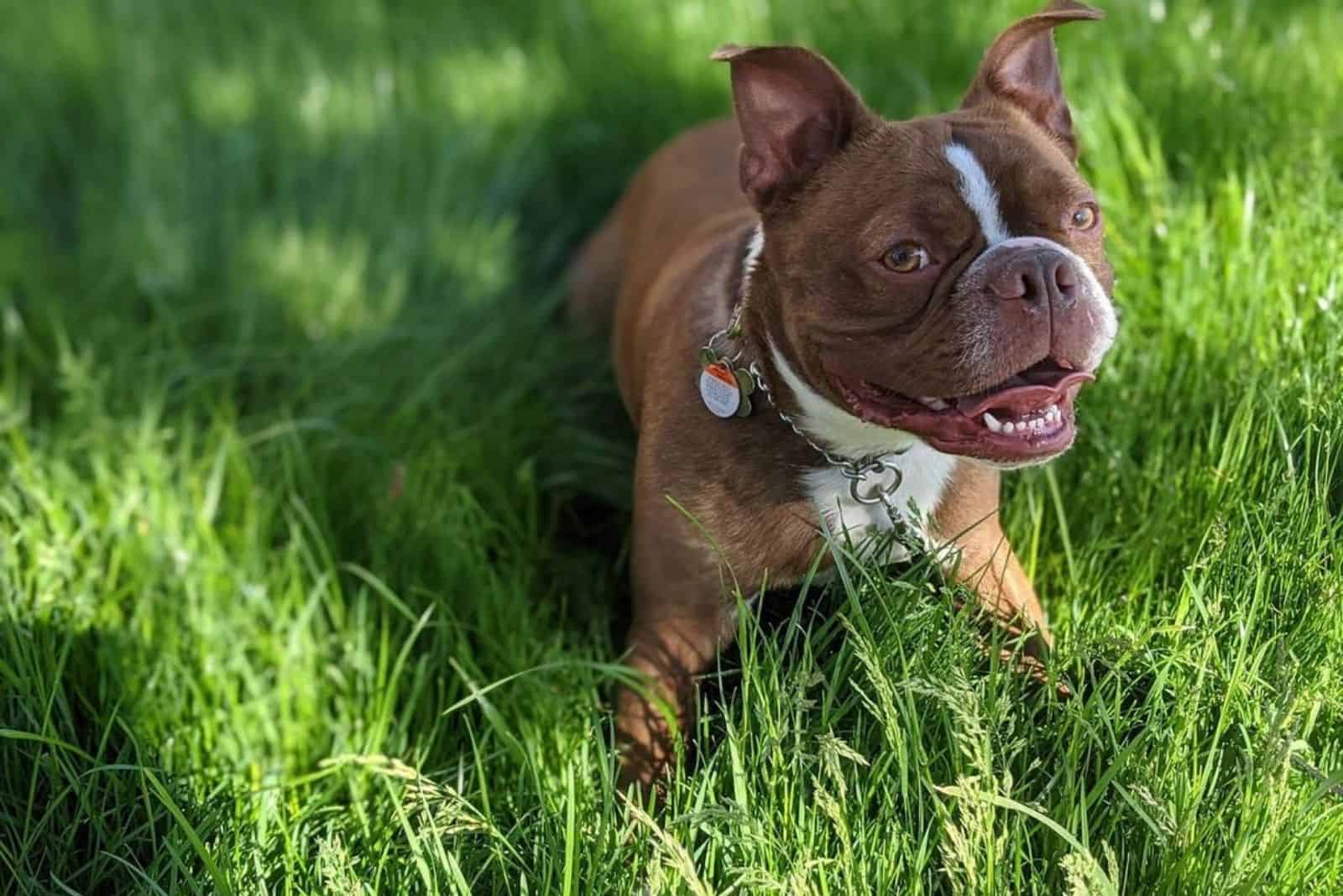
Red Boston Terriers are adorable little dogs and an ideal candidate for your family dog. They are easy to train, and get along with most animals and people when well-socialized. Early socialization is necessary, though, because they can be a bit protective of their primary owner.
The fur color is the only thing that distinguishes it from the rest of the Boston Terriers. Other things are pretty much the same. Therefore, get this pet with complete confidence, and never let the false online information about them mislead you.
From the whole previous discussion, we can get an idea that Red Boston Terrier or Liver Boston Terrier dogs are healthy dogs. However, they do have some health issues, but they are not connected with fur color.
Taking care of these dogs is quite easy – socialize them from an early age, exercise with them, feed them good-quality dog food, brush them, take them to the vet regularly, and, most importantly, love them because happiness starts with a wet nose and ends with a tail most days!
Read Next: Brown Boston Terrier: Interesting Facts & Characteristics
